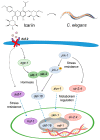Icariin Improves Stress Resistance and Extends Lifespan in Caenorhabditis elegans through hsf-1 and daf-2-Driven Hormesis
- PMID: 38203522
- PMCID: PMC10778813
- DOI: 10.3390/ijms25010352
Icariin Improves Stress Resistance and Extends Lifespan in Caenorhabditis elegans through hsf-1 and daf-2-Driven Hormesis
Abstract
Aging presents an increasingly significant challenge globally, driven by the growing proportion of individuals aged 60 and older. Currently, there is substantial research interest in pro-longevity interventions that target pivotal signaling pathways, aiming not only to extend lifespan but also to enhance healthspan. One particularly promising approach involves inducing a hormetic response through the utilization of natural compounds defined as hormetins. Various studies have introduced the flavonoid icariin as beneficial for age-related diseases such as cardiovascular and neurodegenerative conditions. To validate its potential pro-longevity properties, we employed Caenorhabditis elegans as an experimental platform. The accumulated results suggest that icariin extends the lifespan of C. elegans through modulation of the DAF-2, corresponding to the insulin/IGF-1 signaling pathway in humans. Additionally, we identified increased resistance to heat and oxidative stress, modulation of lipid metabolism, improved late-life healthspan, and an extended lifespan upon icariin treatment. Consequently, a model mechanism of action was provided for icariin that involves the modulation of various players within the stress-response network. Collectively, the obtained data reveal that icariin is a potential hormetic agent with geroprotective properties that merits future developments.
Keywords: Caenorhabditis elegans; aging; healthspan; icariin; lifespan; longevity.
Conflict of interest statement
The authors declare no conflicts of interest.
Figures






Similar articles
-
Icariin and its derivative icariside II extend healthspan via insulin/IGF-1 pathway in C. elegans.PLoS One. 2011;6(12):e28835. doi: 10.1371/journal.pone.0028835. Epub 2011 Dec 21. PLoS One. 2011. PMID: 22216122 Free PMC article.
-
Mitochondrial stress extends lifespan in C. elegans through neuronal hormesis.Exp Gerontol. 2014 Aug;56:89-98. doi: 10.1016/j.exger.2014.03.026. Epub 2014 Apr 4. Exp Gerontol. 2014. PMID: 24709340
-
Tectochrysin increases stress resistance and extends the lifespan of Caenorhabditis elegans via FOXO/DAF-16.Biogerontology. 2020 Oct;21(5):669-682. doi: 10.1007/s10522-020-09884-w. Epub 2020 Jun 6. Biogerontology. 2020. PMID: 32506187
-
Meta-analytic evidence for the anti-aging effect of hormesis on Caenorhabditiselegans.Aging (Albany NY). 2020 Feb 7;12(3):2723-2746. doi: 10.18632/aging.102773. Epub 2020 Feb 7. Aging (Albany NY). 2020. PMID: 32031985 Free PMC article.
-
Hormesis determines lifespan.Ageing Res Rev. 2024 Feb;94:102181. doi: 10.1016/j.arr.2023.102181. Epub 2024 Jan 3. Ageing Res Rev. 2024. PMID: 38182079 Review.
Cited by
-
Ecdysterone and Turkesterone-Compounds with Prominent Potential in Sport and Healthy Nutrition.Nutrients. 2024 May 2;16(9):1382. doi: 10.3390/nu16091382. Nutrients. 2024. PMID: 38732627 Free PMC article. Review.
-
Phlorizin Prolongs the Lifespan of Caenorhabditis elegans by Insulin and SIR-2.1 Regulation.ACS Omega. 2025 Mar 24;10(12):11922-11934. doi: 10.1021/acsomega.4c08725. eCollection 2025 Apr 1. ACS Omega. 2025. PMID: 40191294 Free PMC article.
-
Plants from Bulgarian Botanical Gardens: Some Selected Species with Potential for Health Food and Medical Applications.Plants (Basel). 2025 Jul 14;14(14):2176. doi: 10.3390/plants14142176. Plants (Basel). 2025. PMID: 40733413 Free PMC article. Review.
-
Computer prediction and genetic analysis identifies retinoic acid modulation as a driver of conserved longevity pathways in genetically-diverse Caenorhabditis nematodes.bioRxiv [Preprint]. 2025 Jul 21:2024.10.23.619838. doi: 10.1101/2024.10.23.619838. bioRxiv. 2025. PMID: 40661465 Free PMC article. Preprint.
-
Antiaging Effect of 2-O-β-D-Glucopyranosyl Ascorbic Acid Derived from Lycium barbarum L. Through Modulating the IIS Pathway and Gut Microbiota in Caenorhabditis elegans.Foods. 2025 May 25;14(11):1875. doi: 10.3390/foods14111875. Foods. 2025. PMID: 40509403 Free PMC article.
References
MeSH terms
Substances
Grants and funding
LinkOut - more resources
Full Text Sources
Miscellaneous

